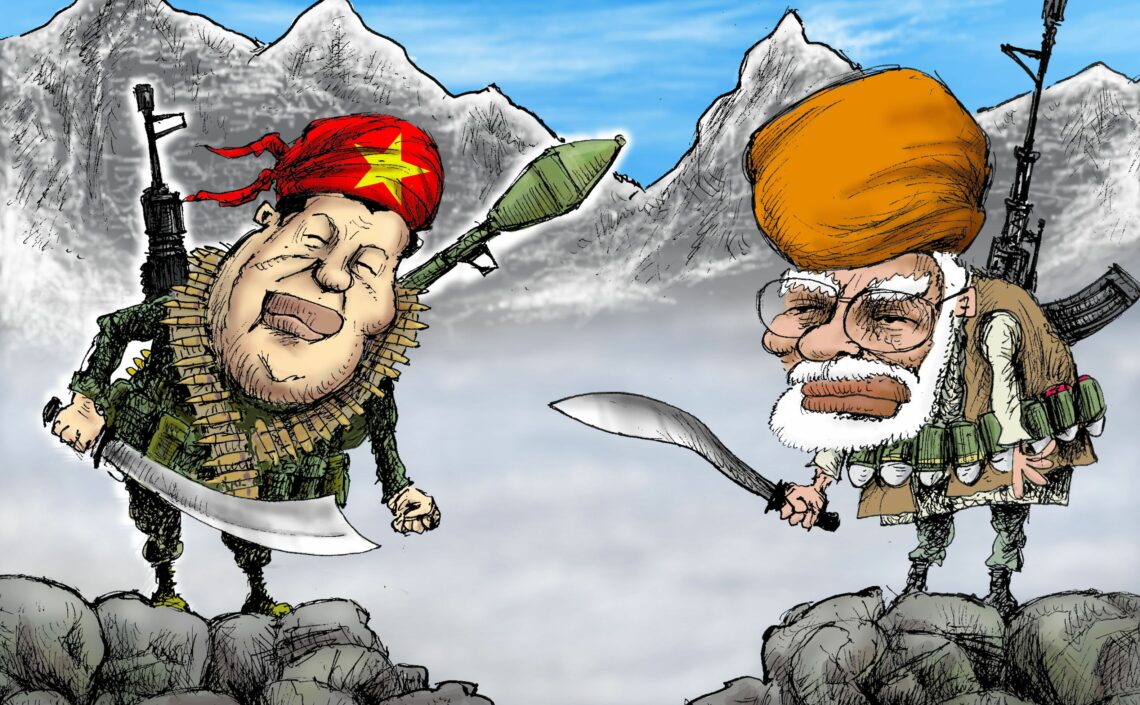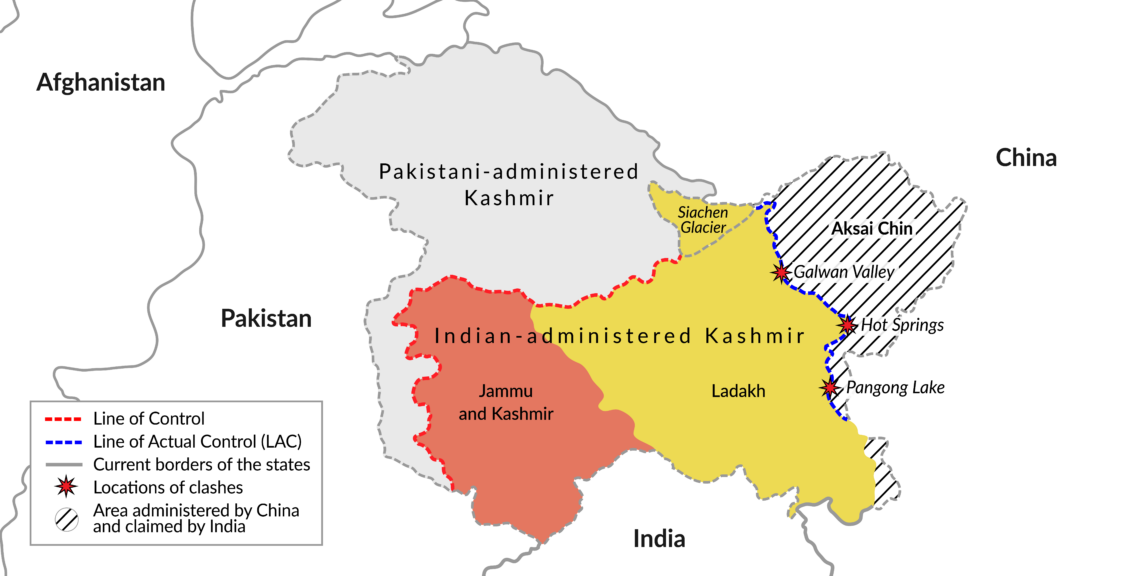Scenarios for the India-China border conflict
As India and China continue to build infrastructure and expand their military forces along the disputed borders in the Himalayas, the hotspots are becoming hotter and the clashes more violent. The Asian giants’ old conflict has entered a new phase.

In a nutshell
- Relations between Beijing and New Delhi reached a new low
- Border disputes between India and China in the Himalayas unlikely to trigger war
- It may, however, accelerate India’s move closer to the West
The bloody brawl of June 15, 2020, between India and China along their disputed border in the Himalayas marked a new low in the complicated, trouble-ridden relationship of Asia’s two largest nations.
Weeks of escalating tensions followed Indian charges that Chinese troops had intruded at three points along the non-demarcated border in the mountainous Ladakh region, one of the two countries’ bones of contention. It culminated in hours of direct fighting in Galwan Valley, which left 20 Indian and an unknown number of Chinese troops dead.
At the two hotspots, the army units have returned to their respective sides of the Line of Actual Control (LAC), as the de facto border is called. But in a third location, Pangong Lake, the Chinese have moved their soldiers eight kilometers forward into a no-man’s-land claimed by both sides. Large military units have since been mobilized on either side of the border, presumably to increase their negotiating leverage as talks are expected to drag on.
The last time troops died violently on that border was 45 years ago.
Facts & figures

New Delhi demands the status quo ante be restored along the LAC. It may take months, if not years before the border becomes stable again. The violence has ended six years of diplomatic engagement in which the two countries tried to rework bilateral relations to reflect their changed economic and military circumstances. Chinese leader Xi Jinping and Indian Prime Minister Narendra Modi met 18 times with the express purpose of defining red lines and clarifying gray zones. Mr. Xi spoke of this as a “historic mission.”
Indian diplomats say the engagement was less about resolving problems, such as the border or trade issues, than about managing the ballooning number of difficulties and safeguarding a new economic relationship. The leaders even held two informal summits to strengthen their rapport.
India now suspects China is more willing to tolerate a degree of friction along its southern border.
There is, of course, no love lost between the two countries. But New Delhi and Beijing previously accepted there was little to gain from a confrontation. Border clashes have been fought with sticks and stones, not rifles and bombs. Disputes have been settled with stringent but nonviolent measures. Some have been games of patience: the 1987 Sumdorong Chu Valley border dispute took eight years to resolve. India now suspects China is more willing to tolerate a degree of friction along its southern border.
Border conflicts between India and China in the Himalayas
| 1962 | The Sino-Indian Border Conflict: started on Oct. 20 and ended on Nov. 21. The fighting took place in Aksai Chin and along the North East Frontier Agency (now known as Arunachal Pradesh) in Assam after a series of violent border skirmishes that followed the 1959 Tibetan uprising and India granting asylum to the Dalai Lama. The Chinese forces were more successful. The war ended when China declared a cease-fire and withdrew its troops to the Line of Actual Control (or LAC, proclaimed by Chinese Premier Zhou Enlai in 1959). |
| 1967 | Nathu La and Cho La clashes: A series of military confrontations between India and China erupted in September along the border of the Himalayan Kingdom of Sikkim, then an Indian protectorate. They lasted four days. In October, a one-day long military exchange took place. In these clashes, Indian forces prevailed and the Chinese army’s fortifications were destroyed. |
| 1975 | Tulung La ambush: In October, four Indian soldiers were ambushed and killed by Chinese soldiers well within Indian territory; their bodies were later returned. New Delhi registered a strong diplomatic protest. |
| 1987 | Sumdorong Chu Valley confrontation: In February, the Chinese and Indian armies faced each other directly, but no battle was fought and there were no casualties. |
| 2013 | Daulat Beg Oldi incursion: In April, according to India, Chinese troops established a camp at a location 19 kilometers inside the Indian side of the LAC and Chinese military helicopters violated Indian airspace delivering supplies to them. A tense face-off ensued. The tension was diplomatically diffused and soldiers were withdrawn in May. |
| 2014 | Demchok construction: In September, Indian workers began building a canal in the border village in the Leh district of Ladakh. Chinese civilians protested and China’s army supported them. After three weeks, both sides withdrew their troops. |
| 2015 | Burtse region incident: In September, Chinese and Indian troops faced-off in northern Ladakh after Indian troops dismantled a disputed watchtower the Chinese were building. |
| 2017 | The Doklam standoff: On June 16, the Chinese began to build a road in an area claimed by China and Bhutan near the Doka La pass. Indian troops intervened quickly. India’s Foreign Ministry stated that China’s construction plan had security implications for India. Bhutan issued a demarche asking China to restore the status quo as of before June 16. Throughout July and August, the Doklam issue remained unresolved. On August 28, India issued a statement saying that both countries had agreed to an ‘expeditious disengagement’ from the area. |
| 2020 | Galwan river valley brawls: 20 Indian soldiers are reported dead; no information is available on casualties among the Chinese troops. |
China’s motives
Several theories circulate in New Delhi as to what could have motivated Beijing to disrupt what had been a relatively stable border.
India’s military analysts believe China wants to maintain its border infrastructure advantage. Over the past two decades, India invested heavily in fortifying its northern border by building roads and air bases, deploying cruise missiles and mountain artillery. Beijing repeatedly triggered incidents to try to block or at least slow down this development. Two of the latest confrontation hotspots are near new highways and bridges built by India parallel to the LAC. However, this hardly explains the ferocity of violence or the Pangong Lake incursion.
Other Indian strategists are inclined to think that Beijing wants to send a message of strategic dominance. Several developments could have prompted this. One was the Doklam border standoff (near Bhutan) in 2017, in which India forced China to stop a road-building project. Another was India’s change of Kashmir’s constitutional status last year, which humiliated China’s ally Pakistan and affected the legal status of the LAC.
India’s previous skirmishes with China have led New Delhi to move closer to the United States.
However, Beijing’s primary concern must have been the slow but steady drift of India toward an alliance with the United States. New Delhi has increased its purchases of U.S. weapons, strengthened military relations and joined in the revival of the Quad – an informal coalition between India, the U.S., Japan, and Australia designed to create a regional buffer against China. The souring U.S.-China relations may be why Beijing has picked fights with Australia and ratcheted up tensions with Japan and India. Chinese leaders may calculate that the Trump administration, preoccupied as it has been with the Covid-19 crisis and the presidential elections, would be slow to respond and appear not dependable to its allies in the region.
In any case, India’s previous skirmishes with China have led New Delhi to move closer to the U.S.
Economic response
India has already erected informal barriers to Chinese investment in its critical infrastructure. And there are internal debates in government whether to expand these to cover more trade and technology. The economic sanctions have become part of India’s broader strategy to pressure China. That strategy is presently unfolding and includes military and diplomatic efforts as well.
India’s government contracts are mainly off-limits to Chinese firms and trade barriers have been imposed on 1,200 low-value Chinese goods, a policy that helps Prime Minister Modi’s attempts to promote domestic manufacturing. Trickier to implement will be the plans to block Chinese-made solar cells and modules, and lure pharmaceutical base ingredients manufacturing into India. New Delhi also counts on wooing the firms leaving China to build a domestic electronics industry, but the scheme has met much skepticism.
Beijing suppressed news about the incidents in China’s local press so it could retract without inflaming public opinion.
While India banned 59 Chinese internet applications at the end of June, it tried to reassure the numerous Chinese venture capital funds. The latter are the biggest foreign investors in the country – they have stakes in 18 of India’s 30 unicorns (privately held start-up companies with evaluation above $1 billion). However, what matters most is that New Delhi will now openly work to oppose Sino-centric digital technology standards in the region. No one is betting on Chinese telecom giant Huawei receiving the clearance to deploy its 5G technology in India.
Scenarios
The most likely scenario is for India and China to agree on a border pullback in the Himalayas, more or less similar to their original positions, but only after several months of confrontation.
While India will reverse some of its economic measures, the tariffs are likely to remain. There will also be a departure from the hedging strategy that India adopted in response to the U.S.-China friction. New Delhi would align more openly with Washington on such issues as technology standards and engage in informal U.S.-led coalitions, like the Quad. There is a limit to the policy shift under this scenario, however. India is not going to consider a more formal relationship with the Americans, given the uncertainty regarding their commitment to Asia.
A second script would flow from renewed violence between India and China along the border in the Himalayas. In that case, India’s responses could become more decisive. Even large Chinese technology investors, like Alibaba, could be evicted. Strategically, India would move much closer to the U.S. and become more aggressive in seeking ways to undermine China. Long-time policy taboos could be broken: New Delhi could sign a free trade agreement with Taiwan and support Tibet’s independence.
China is aware of the risks: officials in India have noted that Beijing suppressed news about the incidents in the Himalayas in China’s local press – a sign that the government is making sure it has an exit path and could retract without inflaming public opinion.
The least likely trajectory would be for India and China to return simply to the status quo ante. By the end of the year, they could pick up their relations where they had been before June 15. India could roll back its economic measures and Messrs. Modi and Xi might consider another informal summit. In this script, border violence would spark a political push to delineate the LAC’s actual location, something that has evaded the two governments for nearly 60 years.








